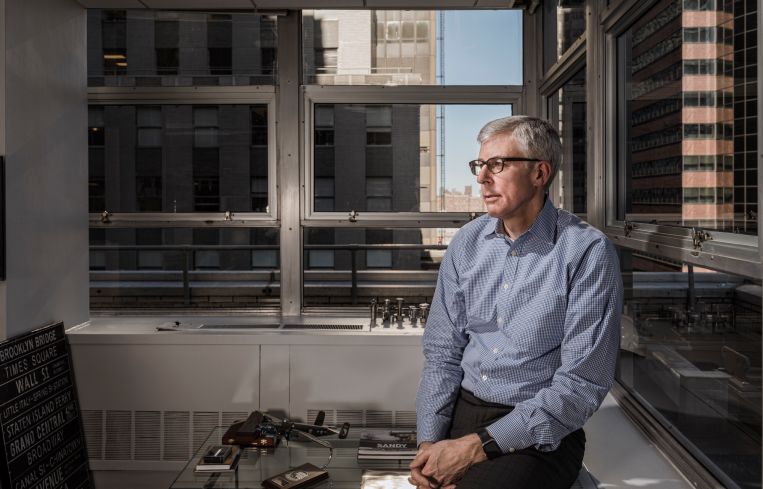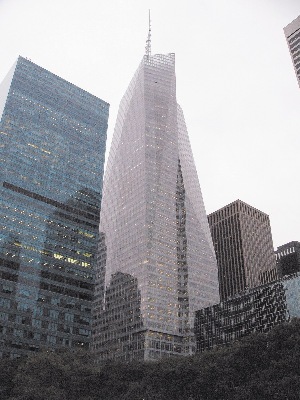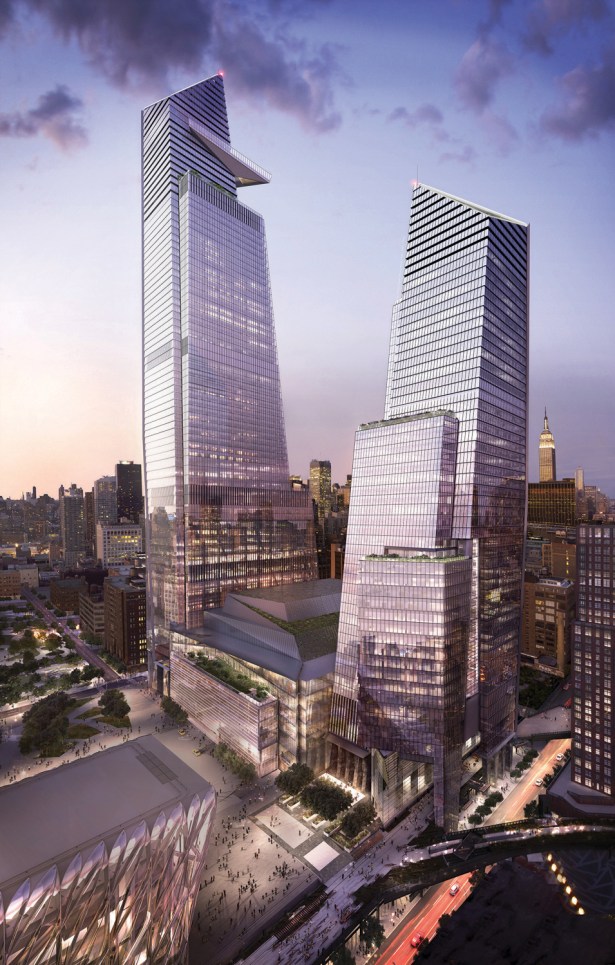JB&B’s Scott Frank Talks Engineering Trends, 1 Bryant Park and Innovations at WTC
By Liam La Guerre March 9, 2017 9:00 am
reprints
Scott Frank, a partner at the 102-year-old engineering firm Jaros Baum & Bolles, also known as JB&B, has worked for just one company since graduating with a masters degree in engineering from Cornell University in 1987.
During his 30-year tenure he has watched the company change, but, then, everything changes in an industry teeming with technological innovation—except for the people managing JB&B. (All 15 partners except one have been there their whole careers.)
The 276-employee firm is responsible for many of the city’s modern icons such as the Bank of America Tower (1 Bryant Park); Columbia University’s Manhattanville campus; the Whitney Museum; and the Eero Saarinen-designed TWA Flight Center at John F. Kennedy International Airport. The firm is also working on all of Related Companies‘ buildings at Hudson Yards.
In addition to his position as one of the top executives at JB&B, nearly two decades ago Frank helped found the New York City chapter of the U.S. Green Building Council, which oversees the LEED accreditation program.
Frank, 51, a married father of two kids (ages 11 and 13) sat down with Commercial Observer in his offices at 80 Pine Street in the Financial District to talk about his life, green building, the World Trade Center and the Javits Center expansion.
CO: Where’d you grow up?
Frank: I grew up in upstate New York in farm country, so I’m one of those classic, “small-town kid comes to the city,” not in a show business context, obviously.
How did you get into engineering?
I came to New York, took a job out of college, kind of on a lark that I would try the city. Growing up at that time in upstate New York you couldn’t in your right mind imagine ever being happy in a big city like New York City.
Why not?
This is in the mid-80s. Big divide. Upstate-downstate, big divide back then.
Tell us about the changes the firm has implemented recently.
We’ve been very aggressive about developing more innovative and more recent technology services around [information technology], around cellular and WiFi or wireless communications and around the audio-visual. High-tech systems that you think of in a smart building, in a smart home, is an area that we’ve really focused on in the last few years, and added key members to grow those businesses.
Is that reflective of where the industry is going?
Yes, technology is really now making its way into the real estate industry. It’s disrupted and penetrated lots of different sectors, and now you can really see it making its way into our space, so we try to be proactive looking strategically at how important these areas are to our clients, and to be leaders in those areas.
What is another example of how the firm has been changing?
Commissioning is an area we’ve developed quite significantly. You know, these buildings—over time—really are becoming more complex. A structured quality control system at the end—kind of like a “shakedown crew” to see what they think of the ship, that in our industry is called “commissioning”—didn’t even exist 20 years ago. But that’s an area [in which] we’ve seen a lot of growth. We see very important roles for us to come in at the end of construction of a project and implement structured testing and procedures to make sure these systems really work the way they should. [Systems are] hard to build and they’re hard to operate, and any breakdown anywhere along the way can mean kind of a sub-optimal outcome for the long life of a building.

Is that a result of the abundance of super-tall buildings?
Well, we’ve had tall buildings [before]. This firm did the original World Trade Center Towers. We did the Sears Tower. There were a lot of innovations at the time that came along with that—we were the first firm to put sprinklers in a high-rise building in Chicago in [the Sears Tower].
So, there have been lots of challenging large buildings. It’s just the complexity. Everything is computer-controlled. The air-conditioning in this room has a whole data network and computers that are operating behind the scenes to make all that work. And when it works, that’s fantastic! But it’s pretty easy to screw up. How many times has your phone not worked with your Apple TV, right? And it’s just those kinds of things, those happen in the commercial [real estate] world, too.
How have things changed since you started in the business?
I started out back in the day in 1987—before computers—as a young engineer working with pencils on big drawings on drafting tables, going home with smudges from number 2 lead on my shirt from working on drawings, and all the while though, continually learning and continually mentoring and growing.
I’ve kind of grown professionally here, becoming an associate after six or seven years, becoming a partner a dozen or so years ago, and now I’m one of three on our executive committee reporting directly to our managing partner. I went from executing engineering tasks on projects to leading small projects to then leading larger projects, all the while managing a few more people and larger teams.
What were the challenges in building the Durst Organization’s Bank of America Tower at 1 Bryant Park, which opened in 2010?
So for that project, Douglas Durst told us at the onset of the project—this was about 2003 or 2004—“I did a lot of things for the first time for 4 Times Square, arguably the first green high-rise building. I don’t want to do anything again that I’ve already done there. One area that we didn’t do a lot of was on water, so I really want to focus on water issues at 1 Bryant Park.” And the most impactful thing that he said that charged the team was: “I want to do what makes sense.” I don’t think anyone realized at that time how prophetic those few words were as we set out to do a number of things that have never been done before, and that’s also kind of the hallmark of this firm.
What kinds of things specifically?
Things that have never been done before. [For example, a] large scale co-generation plant integrated into a high-rise building that was directly grid-connected. That’s putting a power plant inside a tall building, and we broke the mold, so to speak, with how that system was interconnected and succeeded in allowing it to connect with [Consolidated Edison’s] group. But that was a very unpopular and somewhat controversial idea. Con Ed was not in favor of it. There were some regulations that gave them some kind of ammunition or some backing. And, you know, it took a political process with [Gov. George Pataki] to persuade Con Ed because this is what made sense.
Why did it make more sense? It sounds like Con Ed didn’t think so.
Think of a large generator as one huge set of wires and it’s going to connect to thousands and thousands of small wires in a building. Now, the grid already does that. It connects all the big wires to all these gazillion little wires in a building. So as a customer—as a developer—you’re already buying all of that infrastructure. It’s a lot of transformers and circuit boards and switchboards and so forth. Putting this other big-wire gizmo in the building, and trying to get it connected to all these little wires was going to mean duplicating a lot of that infrastructure with a tremendous cost. And the elegance of this is saying, “You know what, the big wire exists right out on the sidewalk. So we can just reach out and connect our big wire gizmo to Con Ed’s big wire gizmo.”
What about the water that Durst wanted?
All the water in the building is recycled and treated. Waterless urinals, first time ever done in New York City. The Building Department had issues, the local officials had issues so we had to work through all that.
I know you lead the sustainability efforts here.
I helped found the New York City chapter of the U.S. Green Building Council 19 years ago. I was on the board of that group for a long time, and had been active in the community promoting this kind of green building and sustainability. So my involvement in 1 Bryant Park was sort of at a third- or quarter-point of my professional trajectory. And that’s led to many other roles and projects based on that experience. So it’s a real point of passion for me.
Why is it a passion for you?
For me, what I can appreciate is that while buildings are so important and so vital to all of us, it’s where we spend 90 percent of our time—we can do things much differently, without compromising very much. Without spending too much money, without making them less beautiful, without making them less functional, and they can make much, much less impact on the earth environment.
I think that there’s such momentum [for green development] already, and there’s such a compelling business case for what you think of as sustainability. Everything you read about the cost of solar power, how that’s plummeting. Those are very significant drivers. And those forces are very much underway.

What projects is your firm working on?
The firm is just finishing all the towers at the World Trade Center. Actually there’s just one more. Tower 2 is still short.
That was a complicated project because there is a huge sub-station at the base of 7 World Trade Center. That was the building we built and designed for Larry Silverstein and that’s where the sub-station is, and that’s what services all of the trade center and lots of Lower Manhattan. There is also a big cooling plant in the basement that uses Hudson River water. That was also reestablished. Incredibly complex, large set of mega-projects. We did the fountain and the museum—another first of its kind.
How does that work?
[The designer] built a mockup of the fountain in his backyard, literally, and we went up and tried to work out how the water would fall and flow rates and so on. There is a lot of science that goes into it. And plus it has to operate through all of the seasons and there is a lot of wind Downtown and so forth.
What other challenges did you have with the World Trade Center buildings?
Emphasis—as you know and expect—for the site post 9/11 was on the security protocols. These buildings were designed under new and innovative standards to protect the facilities for unlikely events. That was a significant challenge and that influenced how those projects were configured and how the systems were organized and protocols for how they would operate in the event of [catastrophe]. That was a major challenge for all of the projects.
This is very confidential information. So all I can say is there was a lot of [security] considerations taken into account in the buildings.
What sustainable technology did you include in the towers?
Each tower was provided with a fuel cell, a power plant in the basement under each tower that generates electricity using hydrogen from natural gas and without any combustion. No smoke stacks or any pollutants coming from those systems that would normally have with a system using natural gas or any kind of fuel. That was a pretty innovative solution that was implemented. Lots of challenges that came along with that. All of the projects capture storm water from the roof and are provided with additional ventilation control.
What other projects are you working on?
Columbia Manhattanville. We are finishing the first part of that campus project. The Steinway Building [111 West 57th Street]—the very thin needle building that’s being built now. We are doing the TWA Flight Center repurposing at JFK Airport—the Eero Saarinen Building. It’s going to be a hotel after being vacant for many, many years.
And you were just announced to be on the Javits Center expansion. What’s that going to be like?
That’s an expansion as you know of the existing convention center to add state-of-the-art convention space and ballrooms. For us that’s just another large project with unique challenges as all large projects have. Of course, it really hasn’t started yet.



